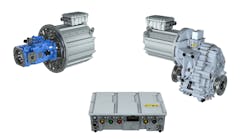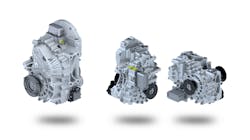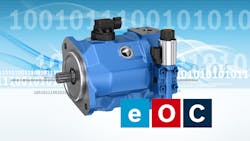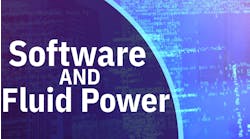Bosch Rexroth Launches Range of Electrification Products for Off-Highway Equipment
Bosch Rexroth is launching a portfolio of high-voltage components for vehicle electrification specifically designed for off-highway mobile equipment. Known as eLION, the line of 700V components include:
- motor-generators,
- inverters,
- gearboxes, and
- software modules.
Additional electrical components such as DC/DC converters, power distribution units, on-board chargers and high-voltage cables are also included in the product range.
Electric Components Meet Heavy-Duty Requirements
The eLION portfolio is defined by the fact it is robust, scalable, and safe said Matthias Kielbassa, vice president, Electrification, Off-Highway Mobile Machines at Bosch Rexroth, during the company’s Electrified Mobile Product & Application Conference (EMPAC) at which it introduced the new product line.
As he explained, ensuring a robust design is vital for components used in mobile off-highway equipment as they work in demanding environments. Machines and their components are exposed to corrosion, dust, shock, vibration, ambient temperatures and more which can cause wear and tear. Because of these factors, Kielbassa said the company decided to develop a dedicated portfolio of products capable of withstanding these environmental conditions instead of adopting existing products.
The entire portfolio is designed with high levels of shock and vibration resistance, as well as higher protection class ratings of IP6K9K. Components feature a shock resistance up to 50 G and vibration resistance of 10 G said Kielbassa. Additionally, all components can be operated without any derating over a wide temperature range. The motor-generator can be operated at a range of -40-100°C (-40-212 F) while the inverters have an operating temperature range of -40-85°C (-40-185 F).
Kielbassa said typical inverters used in factory automation applications can be operated between 0 and 40°C (32 and 104°F). “It is a completely different world and that is why it was necessary to develop a portfolio that can [withstand] the operating conditions [of off-highway applications].”
Scalability of the components within the eLION portfolio was necessary as well to ensure they could meet the varied requirements of the different applications which exist within the off-highway equipment sector. Because of the wide array of duty cycles in this market, it was necessary to develop electric motors capable of meeting various applications’ torque, speed and power requirements.
Unlike passenger cars, off-highway equipment does more than just drive so there are different functions that need to be addressed said Kielbassa. As such, four electric motors with different diameters have been developed covering a power range of 20-200 kW with peak power of 400 kW. Nominal torque provided by the motors goes up to 1,050 Nm and maximum torque up to 2,400 Nm.
The motors are highly configurable to meet various application requirements. The length of the motors can be changed to suit specific machine needs—without additional costs to customers as it is a configuration change, not an engineering one he explained.
Changing the length of the motor provides the same impacts on torque and power as would changing the diameter of the motor. “We can also change the winding configuration of the stator by changing the number of windings and the wire diameter,” said Kielbassa. “That way we can change the nominal speed of the motor and change the electric power of the motor so that in the end, we are able to offer more than 80 different motor variants to the market.”
Making the electric motors configurable in this manner ensures they perform at their optimal working points and maximize energy efficiency of the system into which they are integrated. Use of slightly over- or undersized motors, on the other hand, can bring down efficiency because the motors are not optimized for the system, and this could have a negative impact on total cost of ownership for an OEM’s customers.
Scalability applies to the eLION portfolio’s inverters as well. Kielbassa said there will be three different power classes available—80, 160 and 300 A—which support DC bus voltages from 400-850V. The inverters also include an application-specific high-overload capability of up to factor 2.5 for a maximum of 10 seconds. This prevents the customer from oversizing the machine’s electrical system and allows use of the overload capability when high torque is needed for just a limited amount of time, he explained.
Electrical and functional safety is also built into the components to ensure they perform as designed and do not cause technical issues for OEMs or their customers.
Additional Technologies Benefit Overall Performance
While eLION is comprised of various electronic components, other Bosch Rexroth technologies will work in tandem with them to help provide a fully optimized machine. These include hydraulics, software, and gearboxes. As Peter Fischbach, Electrification Sales and Product Management at Bosch Rexroth, said during EMPAC, the combination of these new electronic components with hydraulics really makes the difference in how a machine performs.
To test and evaluate the eLION components and how they work with other solutions, the company equipped a telehandler with its products. The Rexroth battery-electric telehandler enables Bosch Rexroth to see how its electrification and other products perform for the machine’s driving and working functions. This helps to ensure they will meet OEM customers’ requirements.
Fischbach noted that despite the telehandler being converted to a fully electric power system, hydraulics were still needed for the implement. Bosch Rexroth integrated its eOC (electronic Open Circuit) hydraulic pump which is software controlled and driven by the eLION electric motor. Software control helps to optimize efficiency, noise and create a dynamic system he said.
He also said the pump is connected directly to the motor without shafts or bellhousing which offers many design advantages for OEMs such as a reduction in hoses routed through the machine.
Inclusion of the company’s E-valve aids with precise control of the telehandler boom. When the boom is lowered, no energy is produced, said Fischbach, benefiting operational efficiency of the machine.
The eLION portfolio also includes 1- and 2-speed spur gearboxes, the eGFZ 9100 and eGFZ 9200, which work in conjunction with the electric motors to optimize performance and efficiency. Equipped with its own cooling system, the gearbox is able to manage the temperature of the oil inside of it to ensure optimal performance.
The gearboxes can be provided in different ratios and assembled together with the eLION electric motors. They can be used to drive one or two axles using just the one motor, helping to provide efficient operation without a lot of space claim which is important with electric machines.
With theeGFZ 9200 2-speed gearbox, higher traction force can be achieved by pairing it with the electric motor. A specially designed clutch within the gearbox provides smoother gear shifting which helps to improve comfort for machine operators. Dr. Christof Lamparski, VP Engineering, Gearboxes and Accessories at Bosch Rexroth, said during EMPAC that the absence of friction in the eGFZ gearboxes enables efficiency of 97%.
READ MORE: Battery-Powered Heavy Equipment Comes Closer to Becoming Reality
Market Drivers Necessitate New Electrification Solutions
The off-highway mobile equipment market is expected to continue transforming and become more connected, automated, and electrified said Kielbassa. “By 2030, we expect [around] 30% of off-highway applications will be electrified based on different topologies,” he said.
Because of the company’s deep understanding of drivetrains and working hydraulics as well as the off-highway applications in which its technologies are utilized, Bosch Rexroth was able to “derive what electric products are needed to realize a highly efficient drivetrain,” said Kielbassa.
In addition, he noted the fact Bosch Rexroth has been supplying electric drives and controls for factory automation over the past 40 years which adds to the expertise it could bring to the new eLION product line. As such, the company not only knows how to develop an electric product portfolio but also knows how to industrialize it.
Kielbassa said Bosch Rexroth chose to develop electric components in the 700V range because the commercial vehicle market is moving toward the use of higher voltages. Many manufacturers started at 400V but have moved to 700 and even 800V or higher depending on the application and size of the vehicle or machine, bringing about a need for more high-voltage components in the market.
Advantages to being in the 700V range are the ability to maximize energy efficiency of the entire electrical system and lower charging times for the machine’s batteries said Kielbassa. He also noted that anything above 100V is considered high voltage, therefore requirements for electrical safety are the same no matter the voltage level which benefits product development.
The company has and will continue conducting customer pilot projects with the new electrification components, and expects to begin production in the first half of 2023.





